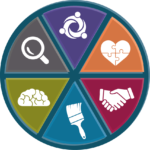Forget cherry, forget potato – there are more important ingredients when it comes to PIE.
(I’ll try and make that my only pie-related joke, but I can’t promise much.)
‘PIE’ refers to ‘Psychologically Informed Environments’, an idea we’ve mentioned before. PIE refers to working in a way that is therapeutic, taking into account the psychological context of the people involved (in this case, The Wallich’s clients). Clients are given elements of choice when it comes to support (not coincidentally, this is a driving principle behind Housing First). PIE should also benefit the staff delivering it.
Key elements of Psychologically Informed Environments are:

Some people consider ‘reflection’, built into the above, a sixth element.
As it is now a requirement for all The Wallich staff, I recently attended a two-day PIE training course. Although PIE wasn’t totally new to me, the training was the first time I really thought about it.
PIE isn’t brand new to The Wallich either. One of our multi-property residential projects in Cardiff, the Community Housing Team, is operating according to PIE. Over the past two years, the pilot has been a valuable learning experience for the organisation, but the support will be continuously evaluated and tweaked to work.
CHT has demonstrated many of the successes that PIE promises. Clients engage more with the initiatives we offer and have taken a much larger role in their own support. Stress-related staff sickness has fallen at the project, as has staff turnover.
PIE made me feel more understood and I was never judged in that atmosphere…I could be me. Struggle through, learn, and know I was supported on that journey.
This doesn’t mean that CHT is no longer chaotic, or that all of our clients are transformed upon moving in. Quite often, progress with complex clients is about slow steps. If the introduction of PIE makes those steps even slightly steadier, it’s worth it.
It’ll be no surprise to learn that PIE costs money. However, down the line there will be practical and financial benefits: the benefits to society of entrenched homeless people being able to work and maintain their own tenancies are myriad.
Many of the practical aspects of PIE are things our excellent support workers already do: for example, we’ve always been wary of evicting people, and favour other solutions whenever possible. However, implementing PIE ensures a consistency of policy in these areas.
An understanding of PIE requires an understanding of Adverse Childhood Experiences (ACEs): negative events in a person’s life before they turn 18 – verbal, physical, or sexual abuse; parental separation; mental illness; domestic violence; substance abuse; incarceration; or emotional and physical neglect.
I never suspected how far-reaching and damaging the effects could be. A 1997 study of an incredible 17,000 participants in California found links between addiction and traumatic experiences. Not every person experiencing mental health issues has had a traumatic upbringing, but people who have experienced this trauma are more likely to develop addictions.
PIE doesn’t argue that children should be wrapped in metaphorical cotton wool and kept safe from anything negative – this wouldn’t be possible or desirable. By understanding ACEs, however, we are more likely to see ‘difficult’ clients as trying to cope with immense amounts of trauma and provide them with better support.
I fear that, perceived incorrectly, ACEs could be used as an ‘excuse’; people might abdicate responsibility for current actions by ‘blaming’ childhood events. Like most people, I’ve made stupid, hurtful, and even cruel choices, but I value personal responsibility, and don’t want to see ACEs being misused this way.
Amazingly, I’ve already heard a story that counters this worry.
Our ‘Shadow Board’ – made up of clients who discuss important issues affecting The Wallich – have undertaken PIE training. Members of the board acknowledged their own traumatic experiences, and realised that they could prevent ACEs by thinking through behaviour with their own children. This is a perfect example of accepting that we can be affected by experiences we had many years ago, without neglecting our responsibilities.
Similarly, the PIE approach allows us to better understand the behaviour of chaotic clients, and to provide effective support, while ensuring the safety of everyone involved.
Given the number of The Wallich projects, the process of rolling PIE out across the organisation will take time. PIE will also apply to our other initiatives. We’ve appointed a Reflections Network manager – building a network of therapists across Wales to deliver counselling to our clients. Working therapeutically is a vital part of PIE. As the rollout continues, I’ll be visiting projects to see PIE working.
PIE isn’t something new, it’s a combination of good practice and continual improvement; it has people at the centre of everything – not policy, procedure and statistics. Many staff at The Wallich already work in a PIE way, which is refreshing.
It’s easy to fall into the trap of seeing PIE as painting walls bright colours, and clients attending cooking classes for the free food. PIE might involve those things, but it is so much more involved than that. These are the basic and visible end of PIE – the crust, or the top. It’s the filling I’ll be reflecting on as we go forward as an organisation. And that’s a pie metaphor, not a joke!
Click here to read more topical blog posts from The Wallich’s Public Affairs and Policy team.